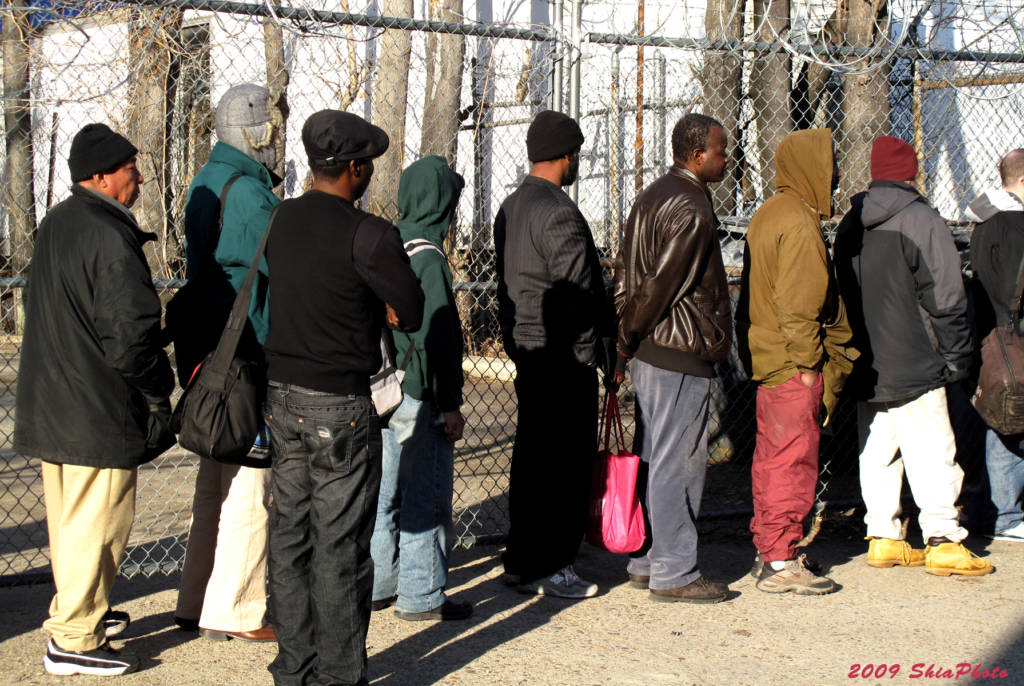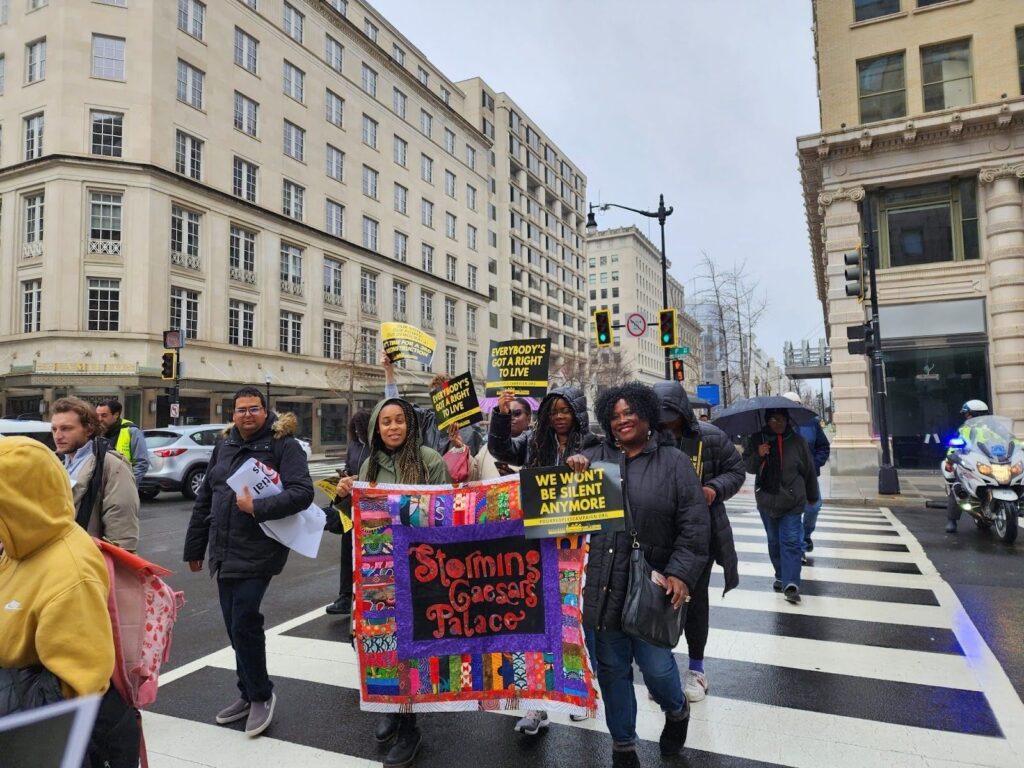An appeal brought against the District government by a group of 42 homeless men who were evicted from the La Casa low-barrier shelter in 2010, has been summarily dismissed on all counts by a three-judge panel of the U.S. Court of Appeals for the District of Columbia Circuit.
The men — overwhelmingly Black and Latino, many of whom had physical and/or mental disabilities — charged the District with discriminating against them. They claimed that disparate treatment and impact in housing accommodations occurred based on their race, in violation of the Fair Housing Act (FHA), and based on their disabilities, in violation of the Americans with Disabilities Act (ADA). The men also charged the District with violating their rights to housing under the D.C. Human Rights Act. Attorneys for the homeless men, George Rickman and Jane Zara, have filed a petition for rehearing to the same U.S. Court of Appeals, but are not optimistic it will be granted, they said in separate interviews with Street Sense.
The petition argues that the Appeals Court’s dismissal relied on uncorroborated testimony from a single city official that showed the theory behind closure of La Casa and Franklin School low-barrier shelters to be a transition between models of care employed by the city, and that the number of Permanent Supportive Housing (PSH) beds being added to the system would be greater than the number of low-barrier shelter beds lost.
Rickman and Zara’s petition contested that these homeless men experience a different situation in practice: that low-barrier shelter residents are not necessarily the same people that will qualify or be awarded PSH. And when some of these men have gone to the remaining low-barrier shelters, they reported being turned away or being admitted only to discover overcrowded and unbearable conditions.
The men’s complaint also charges that the La Casa closure was a deliberate attempt by the District to clear all the remaining low-barrier shelters out of rapidly gentrifying Columbia Heights and make them shift to other poorer and more heavily minority areas of town. Other PSH shelter sites are clustered in Wards 5-8. None of the judges at either the district or appellate court level said there was any direct evidence of that. However, according to the National Fair Housing Alliance website, the U.S. Supreme Court recently “recognized that discrimination is not always overt and that disparate impact is an important tool to permit “plaintiffs to counteract unconscious prejudices and disguised animus that escape easy classification as disparate treatment.”
Yet, assuming the petition fails, both attorneys said they plan to appeal the case to the U.S. Supreme Court. A spokesman for the Office of the Attorney General for the District, which represented the D.C. government in the case, declined to comment on “pending litigation” in an e-mail. The four-page summary dismissal opinion said repeatedly that the homeless men’s arguments were not supported by any direct evidence in the form of signed declarations or other sworn statements that they were denied accommodations at La Casa; all that was presented was general statistics showing the percentage of African-American and Latino men in the District who are homeless, and that the District has a festering problem.
Most discrimination cases are proven by showing direct statistical proof of either disproportionate treatment or impact on members of the protected group. The appeals court said that the men kicked out of this shelter had neither.

However, in earlier versions of the same complaint that were heard in the U.S. District Court for D.C., the lawyers said they had submitted declarations from several of the men saying they had been turned away from other low-barrier shelters after the La Casa closing because of over-crowding, or that the other housing options available were sub-standard or even dangerous.
Additionally, a Greater D.C. Cares fact sheet provided in the rehearing petition said 71 percent of homeless people and more than 50 percent of people in homeless families in D.C. suffer from either substance abuse or a mental illness. The Boykin appeal brief for the homeless men went on to cite the Greater D.C. Cares fact sheet as saying that only nine percent of D.C.’s homeless people do NOT have a disability and that according to D.C.’s FY2006 Consolidated Plan, 82 percent of the District’s homeless community are African-American and eight percent are Hispanic.
While Greater D.C. Cares filed for bankruptcy in 2013, these demographics are echoed in the more recent Metropolitan Council of Government’s 2016 homeless census report that showed 72 percent of homeless single adults and 90 percent of homeless adults in families in the DMV region self-identified as Black or African-American, even though only 25 percent of the region’s total population is Black or African-American. The report also acknowledged that “a significant number of the region’s homeless population suffers from physical disabilities, substance use disorders, severe mental illness, or were formerly institutionalized and discharged directly into homelessness.” Nobody knows where all the La Casa men went, though interviews with several done at a free breakfast program for homeless men in the basement of a church in Columbia Heights suggest that most elected to stay in their home neighborhood and find living accommodations where they could get them, as opposed to taking long bus rides to other shelters in far-flung, over-crowded, unfamiliar, usually poorer and possibly dangerous, parts of the city. There were about 40 PSH units built as part of the high-end apartments that replaced the La Casa shelter, but nobody knows whether any of the La Casa men were among those accommodated there. Only one man interviewed at the breakfast program had successfully obtained a PSH bed at the new La Casa.
Zara and Rickman are angry with the Court and see themselves as fighting for the rights and quality of life of a large, neglected group. They think District government is ignoring or giving lip service to a serious and growing problem. “This is a crisis and it isn’t going anywhere,” said Rickman in a phone interview. “Where’s all the additional shelter space?” It doesn’t take too much to see as you walk around downtown that D.C. has a serious problem. It should be fairly obvious to you as a casual observer that something’s very wrong. [The Bowser administration] is claiming they’re creating all these new spaces, but the men, in reality, are being turned away from them with no place else to go.”
Rickman commented that the District needs to have a realistic plan. He complained that the Appeals Court did not address the issue of where these men went after the shelter they were
depending on was closed. Some faced with that situation will still not choose to go into a shelter because they think they’re overcrowded and dangerous, so they will stay on the street and pitch a tent.
He does think PSH is a good idea if it’s done right. “It’s an important part of the puzzle. You have to take immediate steps; you can’t just get rid of low-barrier shelters without having something to replace them,” Rickman said.
He and Zara made it clear the battle is not over – legally or otherwise. “The door is still open,” Rickman said. “We may have lost this battle, but we haven’t lost the war.” Both would like to see more citizen awareness and activism.
“You’ve got to get in [public officials’] faces and demand better,” Rickman said. “I’m very optimistic that if people knew what was going on in this city, more would be done; they wouldn’t just fret about their property values going down.”
The Boykin suit first began against former-Mayor Adrian Fenty’s administration, when the shelter first closed. It was renamed when Vincent Gray took office and is now inherited again by the Bowser administration.
A spokeswoman for the D.C. Department of Human Services countered that the Bowser administration has made big strides toward dealing with homelessness, but obviously has work to do. “The mayor’s administration has made historic strides toward housing homeless people,” Dora Taylor told Street Sense in a telephone interview. “We’ve drastically increased investments in PSH so that we can move people out of shelters.” Taylor said the District’s stock of PSH space has greatly increased since Bowser took over.
Taylor said that more than 1,300 D.C. singles are now supported in government-run PSH units. These are often done as units in existing apartment buildings; a certain number are set aside for subsidized housing. She noted that housing the homeless is a long, time-consuming process; for example it took three years to build the new supportive housing units now at the La Casa shelter site. Because PSH units offer “wrap-around” services to those they house, such as visits by social workers, nurses and mental health providers in addition to the housing, it takes time and money to get the services the resident needs in place.
There are still several other low-barrier shelters open to homeless men in the District: 801 East on the campus of St. Elizabeth’s Hospital, Adam’s Place shelter at Adams Place NE, and the New York Avenue shelter, according to Taylor.
She is not surprised by the apparent evidence that the La Casa men stayed in the same neighborhood. “We have to get people what they need where we can. I would bet a number of the men who were housed in La Casa have been permanently housed, too.”
A large part of the homeless services team’s job is gaining the trust of the people they aim to serve. “You could still walk downtown and see people experiencing homelessness,” she agreed with Rickman. “We have outreach. It’s a process of gaining trust and assuring folks their needs can be met if they come inside. Sometimes it takes an extended period of time to build that trust.”
Taylor said DHS is looking for landlords to work with them to make affordable housing choices more available. As Zara and Rickman’s efforts continue, a citizens group in affluent Ward 3 filed a lawsuit August 23 to oppose the proposed building of a 50-unit temporary shelter on the parking lot of a police station on Idaho Ave, NW. The shelter residents are expected to be families — mostly mothers with young children — coming in the wake of the planned closing and replacement of the large, debilitated family shelter at the repurposed D.C. General Hospital before 2020. The proposed shelter is one of seven going in every ward of the city except for Ward 2. It would be designed for short stays until the families could get back on their feet.
The citizens group’s concerns are common “not in my back yard” (NIMBY) themes: declining property values, school over-crowding and an influx of criminals. The Ward 3 suit hinges on the same technicality Ivy City residents used to successfully delay construction of a bus depot for years: an injunction based on failure to properly notify the local Advisory Neighborhood Commission (ANC). A recent Washington Post editorial said the city’s most prosperous ward should be able to handle a share of the responsibility for housing their homeless neighbors.








